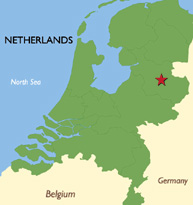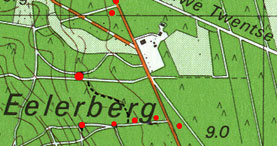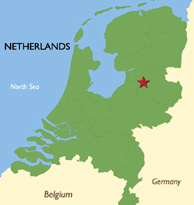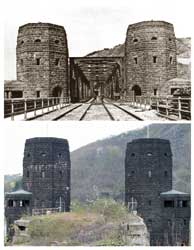 Hellendoorn Hellendoorn
This was the
introduction of the V-weapon, the A4/V2, to the
counties of Twente and
Salland in Holland. The Hellendoorn area was about
to become linked in
history with Hitler's vengeance weapon. The almost
daily sight of the "huge
torpedo shaped projectiles" rising from the forest,
with an even longer
mass of fire coming from the tails, followed by the
long twisting trails
of white smoke high in the heavens (frozen
lightning), became a common
occurrence for the citizens of Hellendoorn. Starting
Nov. 17, V2 rockets
were fired two to four times a day toward Antwerp.
On Nov. 26, two rockets
were fired simultaneously.
It all started in
September of 1944,
the SS-Werfer-Abteilung 500, under command
of SS-Hauptsturmführer
Johannes Miesel, was transported by train from
the Tuchel heather via
Freieinwalde in Pommeren to Rheine near the Dutch
border. In a forest near
Schöppingen (near Burgsteinfurt) at the launch site
code named Schandfleck
(stain, disgrace), the first V2 towards Antwerp was
launched on Oct. 13,
but the projectile didn’t fly farther than 3
kilometers, crashing
in a meadow.
Later, on Nov. 13,
the batterie started
in Hellendoorn (Overijssel). Until Dec. 14, they never
succeeded in launching
more than (4) V2s within 24 hours, but on that date
(7) V2s were launched.
After that they repeatedly succeeded in launching more
than 4 rockets per
day. They averaged one failure for every 5-6 rockets
fired, many crashing
near the launch area.
The strength of
this SS-Werfer-Abteilung 500 was 8 officers
and about 400 crew.
There were about 100 vehicles of several types
available. The classification
of the division was as follows: firing battery,
supply battery, flak-battery,
carpark and I-Staffeln for repair and recovery of
the vehicles (usually
called technical battery) There were also an office,
a nurseroom,
field-kitchen, etc. The firing battery was divided in
three groups (Schiesszüge)
each of 30 man and these again in a special groups for
the rocketpropulsion,
the electrical installations and the Feuerleitpanzer,
from which the projectiles
electrically were fired. The fuel cars belonged to the
supply battery.
Because the
Abteilung
500 was the only SS-Abteilung of the division,
they received special
attention of the division commander, SS-general
Kammler. Repeatedly,
he wished that the SS 500 would become the Abteilung
with the highest average
of launches per 24 hour period. But, it seems that
the extended Wehrmacht
Abteilung
444, that launched toward London, had
achieved the highest result.
Kammler also
made sure that
the SS 500
received the best in equipment
and training. The troops were educated for this
special job in the Freiherr
von Fritsch-Kazerne in Köslin in Pommeren, that under
control of the
Wehrmacht was started as the main education school for
the V2 crews. Here
were courses for the general tactics and technical
head, also special courses
for the firing, the electrotroops, the vehicle troops,
for the leaders
of the Hochfrequenzanlagen (High frequency devices)
and for the battery-troops
(calculating of the launch site, Brennschluss and
Leitstrahlstellung, mounting
of the V2, etc.) The education was both theoretical
and practical, although
of course no rockets were fired. All members of the
Wehrmacht, officers
and crews, also met the V2 here. Only the SS crew,
meant for a special
SS division, had already received a special education.
A part was detached
in the underground factory in Nordhausen, where the
projectiles were made.
In Köslin the lessons were given by civil engineers.
The fact, that
the SS-men on specific orders, received an
extraordinary education at the
rocket factory of Nordhausen, proves that Kammler
wanted to give
his SS-Abteilung an advantage over the other
Abteilungen that all belonged
to the regular army.
 The
A4/V2 rockets were transported from Germany by rail
and delivered to Nijverdal.
Nijverdal had been used for unloading V2’s and local
residents had only
seen rockets passing through by road and suggested
that they were unloaded
west of Nijverdal on the hill. The Dutch residents
at Archem reported that
rockets were unloaded at a siding in the woods
between Marienburg and Ommen.
Two long sidings existed to the south of the main
line running from Marienburg
to Ommen in the woods, these sidings served as a
main unloading point for
rockets. The
A4/V2 rockets were transported from Germany by rail
and delivered to Nijverdal.
Nijverdal had been used for unloading V2’s and local
residents had only
seen rockets passing through by road and suggested
that they were unloaded
west of Nijverdal on the hill. The Dutch residents
at Archem reported that
rockets were unloaded at a siding in the woods
between Marienburg and Ommen.
Two long sidings existed to the south of the main
line running from Marienburg
to Ommen in the woods, these sidings served as a
main unloading point for
rockets.
After unloading,
the vehicles usually went to the presumed launching
site, but occasionally
returned to a parking place in the wood for a short
time before going to
the launching site. Within one or two hours of the
departure of the vehicles
to the launching site, a rocket launch usually took
place.
Rockets were
not unloaded at Ommen station, although alcohol or
some other liquid had
at times been brought there. The Heino station
appears to have been used
mainly as an unloading point for fuel.
At Eelerberg
/ Hellendoorn there were at least 6 - 7 firing
sites, maybe a few more.
Several were located in the Eelerberg forest 1.8
kilometers northwest of
Hellendoorn (Feuerstellung Nr. 410) another closer
to the local sanatorium,
and another (reported) about 1000 meters from the
sanatorium behind an
old castle-like estate. The Eelerberg woods, which
are entirely coniferous,
were crossed by a number of roads and all of the
firing sites were on or
beside these roads. Some of the actual firing
platforms were built on pine
logs cut to equal size, trimmed and bound together
with wire and some were
leveled sand only.
The SS officers
stayed at House
Eelerberg,
under the command of Kommandant Miesel while the men
were housed in farm
buildings near the sites. The second firing platoon
was billeted
in
a house very near the launch sites, and
their vehicles were
parked behind the house. During the launching
periods, men arrived day
and night and there was a constant coming and going
of people carrying
boards and map cases and bringing in reports.
The launches
occurred regularly near Hellendoorn until a break on
Dec. 30. The total
rockets fired up to that point at Hellendoorn was
126, with 15 rockets
crashing during or shortly after lift off. The
troops returned to the Eelerberg
/ Hellendoorn firing sites on Mar. 08, after a short
stint in the Dalfsen
area to the north. The unit returned about 07 March
from Mataram and fired
from 09 – 27 March. At the end of activity, the
daily rate of fire reached
its peak on 17 March when 11 rounds were fired, all
of them aimed at the
Remagen Bridgehead.
On 17 March,
the firing crews stated with great elation that they
had been firing against
the Western Front (the Remagen bridgehead). This was
a matter of common
knowledge in the neighborhood and it was even said
that Hitler had sent
his personal congratulations to the crews for
hitting and destroying the
Remagen Bridge. All the evidence of three residents'
diaries and the tracking
by British Type 9 Mark V Radar proves conclusively
that all the eleven
rounds which fell in the Remagen area came from
the Eelerberg / Hellendoorn
sites.
Click
here
to view large map of Eelerberg / Hellendoorn
launch area
| Entering
the forest Eelerberg near
Hellendoorn. Shown above is the sanatorium as
it appears today. North of
the sanatorium were several launching sites in
the Eelerberg forest. Our
last visit to these areas was in April of
2002. It was from one of these
sites that Cor Lulof saw, for the first time,
the launching of a V2 missile
(see story below). (Photos © Cor Lulof, Tracy
Dungan) |
| About 4
kilometers north of Hellendoorn
is the forest Archem. Here the V2s were
readied at the field store with
warheads and technical adjustments. (Photos ©
V2ROCKET.COM) |
|

 The
locals noticed odd German troop movements on the
afternoon of Nov. 16,
in the forest on the edge of Eelerberg
(Eelermountain) in Hellendoorn.
The ground was still wet from recent rains as dozens
of German rocket soldiers
had arrived, under the cover of night, quite
unexpectedly a few days earlier.
The
locals noticed odd German troop movements on the
afternoon of Nov. 16,
in the forest on the edge of Eelerberg
(Eelermountain) in Hellendoorn.
The ground was still wet from recent rains as dozens
of German rocket soldiers
had arrived, under the cover of night, quite
unexpectedly a few days earlier.

 Hellendoorn
Hellendoorn
 The
A4/V2 rockets were transported from Germany by rail
and delivered to Nijverdal.
Nijverdal had been used for unloading V2’s and local
residents had only
seen rockets passing through by road and suggested
that they were unloaded
west of Nijverdal on the hill. The Dutch residents
at Archem reported that
rockets were unloaded at a siding in the woods
between Marienburg and Ommen.
Two long sidings existed to the south of the main
line running from Marienburg
to Ommen in the woods, these sidings served as a
main unloading point for
rockets.
The
A4/V2 rockets were transported from Germany by rail
and delivered to Nijverdal.
Nijverdal had been used for unloading V2’s and local
residents had only
seen rockets passing through by road and suggested
that they were unloaded
west of Nijverdal on the hill. The Dutch residents
at Archem reported that
rockets were unloaded at a siding in the woods
between Marienburg and Ommen.
Two long sidings existed to the south of the main
line running from Marienburg
to Ommen in the woods, these sidings served as a
main unloading point for
rockets.


























 In
late December of 1944, the SS troops pulled out of
the Hellendoorn area.
It seems that, V1 launching crews near Hellendoorn
were protesting the
fact that V2 trajectories crossed right over the V1
launching sites just
southwest of Hellendoorn. The Luftwaffe crews did
not want the SS launched
missiles crashing down upon them. It was also felt
that the many failures
could be seen by Allied aircraft as large scars in
the forest from above
and this would reveal the firing locations.
In
late December of 1944, the SS troops pulled out of
the Hellendoorn area.
It seems that, V1 launching crews near Hellendoorn
were protesting the
fact that V2 trajectories crossed right over the V1
launching sites just
southwest of Hellendoorn. The Luftwaffe crews did
not want the SS launched
missiles crashing down upon them. It was also felt
that the many failures
could be seen by Allied aircraft as large scars in
the forest from above
and this would reveal the firing locations.
 All
personnel engaged in rocket activities did not live on
the sites, but were
billeted in nearby houses and villages. A senior NCO,
or junior officer,
according to Mr. Janssen, was billeted in the
large house near the
entrance to the park Mataram. He appeared to be in
charge of the site and
had a telephone line to his direct superior who lived
in the village of
Dalfsen.
All
personnel engaged in rocket activities did not live on
the sites, but were
billeted in nearby houses and villages. A senior NCO,
or junior officer,
according to Mr. Janssen, was billeted in the
large house near the
entrance to the park Mataram. He appeared to be in
charge of the site and
had a telephone line to his direct superior who lived
in the village of
Dalfsen.






































